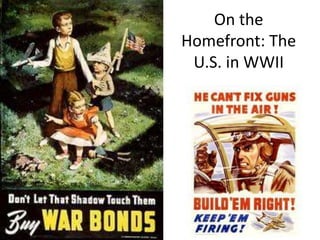On the Homefront
- 1. On the Homefront: The U.S. in WWII
- 2. Rationing âĒ Rationing resulted from the governmentâs need to support the military âĒ Factories began producing war materials instead of consumer goods âĒ Certain types of food became difficult to get (meat, sugar, coffee, gasoline, and shoes) âĒ The government regulated the amount of food items each family could purchase âĒ OPA (Office of Price Administration) oversaw the rationing
- 3. Female Employment âĒ All available citizens were encouraged to work in some way to support the war âĒ 250,000 women served in auxiliary branches of the armed services (nurses and clerical workers) âĒ Women entered jobs that had not been open to them before, especially factory work in manufacturing industries âĒ Out of 18 million defense workers, 6 million were women âĒ Women earned 40 percent less than men doing the same jobs âĒ Womenâs Auxiliary Army Corps (WAAC) helped the military during the war (nurses, ambulance drivers, radio operators, electricians)
- 4. End of the Great Depression âĒ Brought about by government spending on weapons, airplanes, ships, and other equipment âĒ The war increased production and created jobs in the United States âĒ Much of the governmentâs spending on war goods was deficit spending âĒ Unemployment dropped from 17.2% in 1939 to 9.9% in 1941 to 4.7% in 1942 âĒ Increased consumer spending helped the economy- Americans spent money on entertainment (movies and books) âĒ Desire for news helped the publishing and radio industries grow
- 5. Labor âĒ The selective service system instituted a draft that provided the nation with 10 million additional soldiers âĒ Defense contractors called for more workers to keep up with the demand for more war materials âĒ 6 million women would answer the call (Rosie the Riveter) and more than 2 million minorities would help the war effort âĒ A. Phillip Randolph (African-American labor leader- Brotherhood of Sleeping Car Porters) organized a march on Washington that forced President Roosevelt to issue an executive order stopping discrimination in defense industries
- 6. Minorities Serving âĒ African-Americans, Mexican- Americans, and Japanese Americans: defended their nation by joining the military or working in defense industries âĒ Many minorities encountered discrimination and racism- CORE (Congress of Racial Equality, sit-ins, marched/protested, boycotted) and JACL (Japanese Americanâs Citizens League, sought compensation for Japanese Americans forced into internment camps)
- 7. Children at the Weill public school in San Francisco pledge allegiance to the American flag in April 1942, prior to the internment of Japanese Americans. A Japanese American unfurled this banner the day after the Pearl Harbor attack. This Dorothea Lange photograph was taken in March 1942, just prior to the man's internment. Official notice of exclusion and removal
- 8. Internment camps and further institutions of the War Relocation Authority in the western United States.
- 9. Internment of Japanese Americans âĒ In the name of national security, many Japanese-Americans were forced to move to special detainment camps starting in 1942 (many thought they were spies even though no evidence supported this conclusion) âĒ 1% of Hawaiiâs Japanese-Americans population (1,444) interned; 110,000 Japanese-Americans in California and other Western states were sent to camps âĒ 2/3 of those interned were Nisei, or American born citizens. Many had been drafted into the army and wanted to fight against the Axis powers Heart-Mountain Camp








